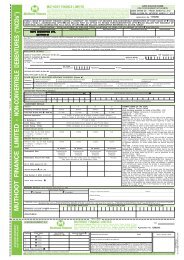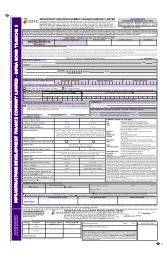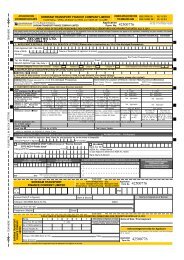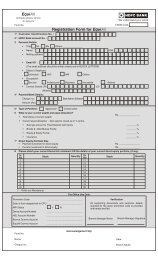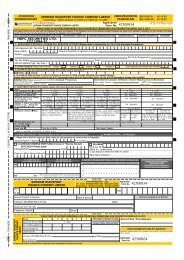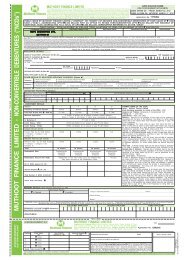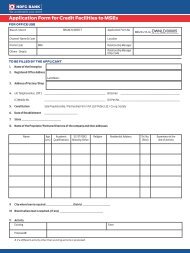INFRASTRUCTURE
IDFC-APPLICATION FORM-13-3-2012.p65 - HDFC Bank
IDFC-APPLICATION FORM-13-3-2012.p65 - HDFC Bank
- No tags were found...
You also want an ePaper? Increase the reach of your titles
YUMPU automatically turns print PDFs into web optimized ePapers that Google loves.
7IN THE NATURE OF FORM 2A - MEMORANDUM CONTAINING SALIENT FEATURES OF THE PROSPECTUS - TRANCHE 3<strong>INFRASTRUCTURE</strong> DEVELOPMENT FINANCE COMPANY LIMITEDthe value of AUM also can affect the level of our operating expenses. In addition, excluding any distribution costs, most of our costs do not vary directlywith AUM or income. As a result, our operating margins may fluctuate by a higher percentage than changes in income.17. Our investment funds business is subject to a number of risks and uncertainties.: Our subsidiary IDFC Private EquityCompany Limited is the investment manager for three funds and manages a corpus of ` 57,348.7 million as on January 31, 2012. Formore details of these funds, please see the section entitled "Our Business - Alternative Asset Management" on page 69 of theProspectus Tranche 3. Existing and potential investors in our funds continually assess our investment funds' performance, and ourability to raise capital for future investment funds will depend on our investment funds' continued satisfactory performance. Fiscal 2011witnessed high levels of activity in the performance of our investment funds with the successful closure of a key man event, one newinvestment, three follow-on investments and eight exits/liquidity events (including 3 full exits and 1 partial exit). We believe this is thehighest number of exits/liquidity events made by any private equity firm in India during the year. If any of our investment funds were toperform poorly, the value of our assets under management would decrease. This would also result in a reduction in our managementand incentive fees and carried interest. Moreover, we could experience losses on our investments as principal as a result of poorinvestment performance by our investment funds. This could adversely affect our ability to expand our funds business, which is oneof the key elements of our strategy. Further, any adverse regulatory action in relation to the investment fund business or the sector inwhich we have investments may have an adverse impact on our business and results of operations. Thus, if we are unable to manageforeseeable and unforeseen risks and uncertainties in our investment management, it could affect our overall profitability and performance.18. If the investment strategy for any of our funds goes out of favour with our clients, our income and profit may bematerially adversely affected.: Our investment strategy in relation to any of our funds could go out of favour with our clients for anumber of reasons, such as our inability to formulate an appropriate investment strategy, incorrect presumption about risks andbenefits, underperformance relative to market indices, competition or other factors. If our investment strategies were to go out of favourwith our clients, it could potentially cause our clients to reduce the assets that we manage for them. However, it should be noted thatthe clients make firm commitments and can default in payment of their contributions, in which case the Company has the ability toforfeit units already subscribed by them and allot the balance unsubscribed units to other eligible investor(s), subject to Companyfinding such investor(s). Our inability to formulate new investment strategies or offer new products promptly if market conditionschange or new opportunities arise also may adversely affect the growth of our AUM. A decrease in our AUM may have a materialadverse effect on our business, prospects, results of operations and financial condition.19. We have a limited history with respect to acting as an infrastructure developer and we are subject to all of thebusiness risks and uncertainties associated with commencing a new business in general, and with infrastructuredevelopment in particular.: We established IDFC Projects Limited in 2007, to act as an infrastructure developer. However, we havevery limited experience in developing infrastructure projects and, as of the date of the Prospectus - Tranche 3, we have a majorityinterest in a company which is setting up a 1,050 MW coal-fired power plant in Chhattisgarh and a 26 per cent. stake in a companywhich has entered into a concession agreement with NHAI for the four laning of the Jetpur-Somnath section of the NH-8D in Gujaratfor a distance stretching to 127.6 km on a BOT basis. Our success as an infrastructure developer will depend, among other things, onour ability to attract and retain talented and experienced personnel and to build relationships with partners and co-developers. We maynot have control over joint ventures incorporated for undertaking infrastructure projects. Additionally, we are subject to all of thebusiness risks and uncertainties associated with any new business enterprise, including the risk that we will not achieve our objectiveswithin the estimated time period, or at all. Any inability to effectively develop or operate the projects, which we are developing or expectto develop, could adversely affect our business, prospects, results of operations and financial condition.20. Any infrastructure projects we develop will require significant capital expenditure for which we will require additionalcapital. If we are unable to obtain the necessary funds on acceptable terms, our growth plans could be adverselyaffected.: Our funding requirements for infrastructure projects that we seek to develop through IDFC Projects Limited are likely to besubstantial, and our ability to finance these plans are subject to a number of risks, contingencies and other factors, some of which arebeyond our control, including availability of liquidity, general economic and capital markets conditions and our ability to obtain financingon acceptable terms, in a timely manner, or at all. Furthermore, adverse developments in the Indian credit markets or a reducedperception in the credit markets of our creditworthiness could increase our debt service costs and the overall cost of our funds.Additionally, due to the number of large scale infrastructure projects currently under development in India and increased lending bybanks and financial institutions to such projects, we may not be able to receive adequate debt funding on commercially reasonableterms. We cannot assure you that debt or equity financing or our internal accruals will be available or sufficient to meet our capitalexpenditure requirements. Our ability to obtain the required capital on acceptable terms is subject to a variety of uncertainties,including:● limitations on our ability to incur additional debt, including as a consequence of regulatory and contractual restrictions andprospective lenders' evaluations of our creditworthiness and pursuant to restrictions on incurrence of debt in our existing and anticipatedcredit facilities; ● limitations on our ability to raise capital in the capital markets and conditions of the Indian, U.S. and other capitalmarkets in which we may seek to raise funds; and ● our future results of operations, financial condition and cash flows. Any inability toraise sufficient capital, or any delays in raising capital, to fund our infrastructure projects could adversely affect our business, prospects,results of operations and financial condition.21. We are subject to credit, market and liquidity risks, and if any such risks were to materialize, our credit ratings andour cost of funds could be adversely affected.; To the extent any of the instruments and strategies we use to hedge or otherwisemanage our exposure to market or credit risks are not effective, we may not be able to mitigate effectively our risk exposures inparticular market environments or against particular types of risks. Our trading revenues and interest rate risk are dependent upon ourability to properly identify, and mark to market, changes in the value of financial instruments caused by changes in market prices orrates. Our earnings are dependent upon the effectiveness of our management of migrations in credit quality and risk concentrations,the accuracy of our valuation models and our critical accounting estimates and the adequacy of our allowances for loan losses. To theextent our assessments, assumptions or estimates prove inaccurate or are not predictive of actual results, we could incur higher thananticipated losses. The successful management of credit, market and operational risk is an important consideration in managing ourliquidity risk because it affects the evaluation of our credit ratings by rating agencies. Rating agencies may reduce or indicate theirintention to reduce the ratings at any time. For example, one of the rating agencies had downgraded our debt grading from AAA to AA+in July, 2009 and there can be no assurance that we may not experience such downgrade in the future. The rating agencies can alsodecide to withdraw their ratings altogether, which may have the same effect as a reduction in our ratings. Any reduction in our ratings(or withdrawal of ratings) may increase our borrowing costs, limit our access to capital markets and adversely affect our ability to sellor market our products, engage in business transactions, particularly longer-term and derivatives transactions, or retain our customers.This, in turn, could reduce our liquidity and negatively impact our operating results and financial condition. In addition, as an IFC,banks' exposures to us are risk-weighted in accordance with the ratings assigned to the Company by the rating agencies registeredwith the SEBI and accredited by the RBI. Our classification as an IFC is dependent upon the credit rating we obtain and maintain.Although we believe that we have adequate risk management policies and procedures in place, we may still be exposed to unidentifiedor unanticipated risks, which could lead to material losses.22. Our consolidated contingent liabilities not provided for could adversely affect our financial condition.: As of March 31,2011, we had consolidated contingent liabilities not provided for of ` 23,536.4 million, including `7,288.9 million of capital commitmentsand ` 12,344.5 million of financial guarantees. We also had `1,184.8 million of contingent liabilities as on March 31, 2011 whichdecreased to ` 1,070.7 million of contingent liabilities on account of income tax disputes as on January 31, 2012. If these contingentliabilities fully materialize, our financial condition could be adversely affected. For further details of our contingent liabilities, please seethe section entitled "Financial Statements" beginning on page F-1 of the Prospectus Tranche 3.23. Our success is dependent upon our management team and skilled personnel and our ability to attract and retainsuch persons.: Our future performance will be affected by the continued service of our management team and our ability to attractand retain skilled personnel. We also face a continuing challenge to recruit and retain a sufficient number of suitably skilled personnel,particularly as we utilize the experienced understanding of our management of risks and opportunities associated with our business,and continue to grow and broaden our business activities. Our diversification strategy with its emphasis on principal investments, loansyndication, institutional brokerage, asset management and investment banking, and corporate and advisory services, requireshighly qualified and skilled personnel. There is significant competition in India for such personnel, and it may be difficult to attract,adequately compensate and retain the personnel we need in the future. We do not maintain a "key man" insurance policy. Inability toattract and retain appropriate managerial personnel, or the loss of key personnel could adversely affect our business, prospects,results of operations and financial condition.24. Foreign currency lending or borrowing will expose us to fluctuations in foreign exchange rates.: We are affected by adversemovements in foreign exchange rates to the extent they affect our borrowers negatively, which may in turn adversely affect the quality of ourexposure to these borrowers. As of January 31, 2012, we had foreign currency borrowings of U.S.$ 937.5 million. While we currently seek tohedge foreign currency exposures, as our business grows and we seek greater amounts of foreign currency funds (for example, as an IFC,we have greater access to external commercial borrowings), we could be exposed to a greater extent to fluctuations in foreign currency rates.Volatility in foreign exchange rates could adversely affect our business, prospects, results of operations and financial condition.25. We are involved in certain legal proceedings that, if determined against us, could adversely impact our business andfinancial condition. : We are subject to certain significant legal proceedings that could adversely impact our business and financialcondition. These include: ● We are involved in a number of disputes pending with the Income Tax Department with respect to incometax assessments for the assessment years 1997-1998, 1999-2000, 2000-2001, 2001-2002, 2002-2003, 2003-2004, 2004-2005,2005-2006, 2006-2007, 2007-2008,2008-2009 and 2009-2010. The aggregate income tax liability in dispute is ` 1,070.7 million ason January 31, 2012. ● In fiscal 2004, we sanctioned and disbursed a loan of ` 300.0 million to Data Access (India) Limited ("DAIL")for use in connection with its Internet service provider business. As a result of a promoter dispute and a winding up petition filed by oneof DAIL's promoters. The High Court of Delhi on November 18, 2005 awarded a winding up order against DAIL and appointed anofficial liquidator (the "Official Liquidator") to take charge of DAIL's assets. As security against the loan, we hold a number of shares inDAIL. However, a group of new investors filed a suit against us seeking to prevent us from selling DAIL's shares held by the Company,and the Madras High Court subsequently passed a temporary order preventing us from disposing of our shareholding in DAIL. Thematter is still pending before the Madras High Court. On August 26, 2005, the Company filed a recovery application in the DebtRecovery Tribunal, New Delhi against the guarantors under the loan to DAIL, namely Siddharth Ray and SPA Enterprises Limited forrecovery of an amount aggregating to `314.1 million. The Company has filed its evidence in the matter. The recovery application willbe taken up for arguments before the Debt Recovery Tribunal. In February 2008, the Company filed a recovery application againstDAIL for recovery of `465.40 million in the Debt Recovery Tribunal, New Delhi, where Canara Bank is also impleaded as a defendant.The Company prayed for issuing of a certificate of recovery in its favour by the Debt Recovery Tribunal. The final order is awaited. ●Following Vodafone International Holdings BV's ("Vodafone") agreement with Hutchison Telecommunications International Limited("HTIL") for the acquisition of a controlling stake in Hutchison Essar Limited ("HEL"), an organization called the Telecom Watchdogfiled a civil writ petition before the High Court of Delhi alleging breach of the 74 per cent. sectoral cap for foreign direct investment byVodafone in HEL. The Government, along with 21 other entities, including our Company were made respondents under this writpetition. The petitioner has alleged that SMMS Investments Private Limited (which was held 49 per cent. by the Company, 49 per cent.by IDF and 2 per cent. by SSKI Corporate Finance Limited (now IDFC Capital Limited)) holds its 54.21 per cent. investment in OmegaTelecom Holdings Private Limited (which in turn held 5.11 per cent. equity interest in HEL) as a nominee of HTIL. On May 7, 2007, theMinistry of Finance, Government approved the acquisition of a controlling stake in HEL by Vodafone. However on May 10, 2007Telecom Watchdog filed an application before the High Court of Delhi for the revival of the civil writ petition. The High Court of Delhiissued revival notice and granted liberty to Telecom Watchdog to amend the writ petition. Telecom Watchdog filed writ petitioninvolving Vodafone also as a party. The matter is pending. ● Delhi Gurgaon Super Connectivity Limited ("DGSCL") and NHAI areinvolved in a dispute arising out of Concession Agreement signed between them for a road project. NHAI has issued a terminationnotice. We have an exposure of approximately ` 5,550.0 million on DGSCL. As an affected party, a consortium of lenders includingthe Company filed for an injunction and also to direct NHAI to execute escrow agreement and substitution agreement. The matter had comeup for hearing on March 1, 2012 and a stay has been granted. Consequently the interim orders are to continue; i.e. the termination of theconcession agreement has not been given effect to. The matter is posted on March 27, 2012 for further hearing. Further, in the past, IDFCCapital Limited and IDFC Securities Limited have received show-cause notices from the SEBI and income tax authorities. For furtherdetails, please see the section entitled "Outstanding Litigations and Default" on page 98 of the Prospectus Tranche 3.26. We have debt agreements which contain restrictive covenants, placing limitations on us.: Some debt agreements enteredinto by the Company contain restrictive covenants including certain restrictions relating to the diversification of our business. These restrictionsmay impede the growth of our business. We have recently secured our outstanding borrowings by a floating charge over our receivables. Anyinability to comply with the provisions of our debt agreements and any consequent action taken by our lenders, including an enforcement ofthe security, may adversely affect our business, prospects, results of operations and financial condition.27. Our transition to IND AS reporting could have a material adverse effect on our reported results of operations orfinancial condition.: On February 25, 2011, the Ministry of Corporate Affairs, Government, of India ("MCA"), notified that the IND ASwill be implemented in a phased manner. It was also mentioned that the date of implementation of IND AS will be notified by the MCAat a later date. As of the date of the Prospectus - Tranche 3, the MCA has not yet notified the date of implementation of IND AS.Additionally, IND AS has fundamental differences with IFRS and hence financial statements prepared under IND AS may be substantiallydifferent from financial statements prepared under IFRS. There can be no assurance that the financial condition, results of operations,cash flow or changes in shareholder's equity of the Company will not appear materially different under IND AS than under IndianGAAP. As our Company adopts IND AS reporting, it may encounter difficulties in the ongoing process of implementing and enhancingits management information systems. Moreover, there is increasing competition for the small number of IND AS-experienced accountingpersonnel available once Indian companies begin to prepare IND AS financial statements. There can be no assurance that theadoption of IND AS by the Company will not adversely affect its reported results of operations or financial condition and any failure tosuccessfully adopt IND AS in accordance with the prescribed timelines could have a material adverse effect on our financial positionand results of operations.RISKS RELATING TO THE INDIAN ECONOMY28. A slowdown in economic growth in India could cause our business to be adversely affected.: We and most of oursubsidiaries are incorporated in India, and substantially all of our assets and employees are located in India. As a result, we are highlydependent on prevailing economic conditions in India and our results of operations are significantly affected by factors influencing theIndian economy. Any slowdown in economic growth in India could adversely affect us, including our ability to grow our asset portfolio,the quality of our assets, and our ability to implement our strategy. In recent years, India has been one of the fastest growing majoreconomies in the world, recording a GDP growth rate at factor cost of 8.0 per cent. in 2009-10 and 8.6 per cent. during the year 2010-11. The current challenges for the economy are high oil and other commodity prices and inflation, which followed by RBI's antiinflationarymonetary stance, has the potential to moderate growth. A slowdown in the rate of growth in the Indian economy couldresult in lower demand for credit and other financial products and services and higher defaults. Any slowdown in the growth or negativegrowth of sectors where we have a relatively higher exposure could adversely impact our performance. Any such slowdown couldadversely affect our business, prospects, results of operations and financial condition.29. Increased volatility or inflation of commodity prices in India could adversely affect the Company's business.: In recentmonths, consumer and wholesale prices in India have exhibited marked inflationary trends, with particular increases in the prices of food andcrude oil. Inflation measured by the Wholesale Price Index decreased from 10.4 per cent. at March 31, 2010 to 9.7 per cent. at March 31,2011. Any increased volatility or rate of inflation of global commodity prices, in particular oil metals and metal products prices, could adverselyaffect the Company's borrowers and contractual counterparties. This may lead to slowdown in the growth of the infrastructure and relatedsectors could adversely impact the Company's business, financial condition and results of operations.30. Significant shortages in the supply of crude oil or natural gas, and other raw materials, could adversely affect theIndian economy and the infrastructure sector, which could adversely affect us.: In fiscal 2010, India imported approximately159.26 million tonnes of crude oil. Crude oil prices are volatile and prices have risen in recent years due to a number of factors suchas the level of global production and demand and political factors such as war and other conflicts, particularly in the Middle East. InJune 2010, the Government eliminated subsidies on petroleum products, which will significantly increase the price of gasoline, dieseland kerosene. Any significant increase in oil prices could adversely affect the Indian economy, including the infrastructure sector, andthe Indian banking and financial system. Prices of other key raw materials, for example steel, coal and cement, have also risen inrecent years and if the prices of such raw materials approach levels that project developers deem unviable, this will result in aslowdown in the infrastructure sector and thereby reduce our business opportunities, our financial performance and our ability toimplement our strategy. In addition, natural gas is a significant input for infrastructure projects, particularly those in the energy sector.India has experienced delays in the availability of natural gas which has caused difficulties in these projects. Continued difficulties inobtaining reliable, timely supply of natural gas could adversely affect some of the projects we finance and could impact the quality ofour asset portfolio and our business, prospects, results of operations and financial condition.31. Financial instability in other countries could disrupt our business.: The Indian market and the Indian economy areinfluenced by economic and market conditions in other countries. Although economic conditions are different in each country, investors'reactions to developments in one country can have adverse effects on the economy as a whole, in other countries, including India. Aloss of investor confidence in the financial systems of other emerging markets may cause volatility in Indian financial markets andindirectly, in the Indian economy in general. Any worldwide financial instability could also have a negative impact on the Indianeconomy, including the movement of exchange rates and interest rates in India. In the event that the current difficult conditions in theglobal credit markets continue or if the recovery is slower than expected or if there any significant financial disruption, this could havean adverse effect on our cost of funding, loan portfolio, business, prospects, results of operations and financial condition.32. Political instability or changes in the Government could adversely affect economic conditions in India andconsequently, our business.: The Government has traditionally exercised and continues to exercise a significant influence overmany aspects of the economy. Since 1991, successive governments have pursued policies of economic and financial sector liberalisationand deregulation and encouraged infrastructure projects. The current Government, which came to power in May 2009, is a coalitionof several political parties. Although the previous Governments had announced policies and taken initiatives that supported theeconomic liberalisation programme pursued by previous governments, the policies of subsequent Governments may change the rateof economic liberalisation. A significant change in the Government's policies in the future, particularly in respect of the banking andfinance industry and the infrastructure sector, could affect business and economic conditions in India. This could also adversely affectour business, prospects, results of operations and financial condition.33. If regional hostilities, terrorist attacks or social unrest in India increases, our business could be adversely affected.: India has from time to time experienced social and civil unrest and hostilities within itself and with neighbouring countries. India hasalso experienced terrorist attacks in some parts of the country. In November 2008, several coordinated terrorist attacks occurredacross Mumbai, India's financial capital, which resulted in the loss of life, property and business. These hostilities and tensions and/orthe occurrence of similar terrorist attacks have the potential to cause political or economic instability in India and adversely affect ourbusiness and future financial performance. Further, India has also experienced social unrest in some parts of the country. If suchtensions occur in other parts of the country, leading to overall political and economic instability, it could have an adverse effect on ourbusiness, prospects, results of operations and financial condition.34. Natural calamities could have a negative impact on the Indian economy and could cause our business to be adverselyaffected.: India has experienced natural calamities such as earthquakes, floods and drought in the recent past. The extent andseverity of these natural disasters determine their impact on the Indian economy. In previous years, many parts of India receivedsignificantly less than normal rainfall. As a result, the agricultural sector recorded minimal growth. Prolonged spells of below normalrainfall in the country or other natural calamities could have a negative impact on the Indian economy, thereby affecting our business.35. Difficulties faced by other banks, financial institutions or NBFCs or the Indian financial sector generally could causeour business to be adversely affected.: We are exposed to the risks of the Indian financial sector which in turn may be affected byfinancial difficulties and other problems faced by Indian financial institutions. Certain Indian financial institutions have experienceddifficulties during recent years particularly in managing risks associated with their portfolios and matching the duration of their assetsand liabilities, and some co-operative banks have also faced serious financial and liquidity crises. Any major difficulty or instabilityexperienced by the Indian financial sector could create adverse market perception, which in turn could adversely affect our business,prospects, results of operations and financial condition.36. The proposed new taxation system could adversely affect the Company's business and the price of the Tranche 3Bonds.: In its Union Budget for Fiscal Year 2010, the Government proposed two major reforms in Indian tax laws, namely the goodsand services tax and the direct taxes code, which are proposed to be effective starting 1 April 2011 and 1 April 2012, respectively.Subsequently, in the Union Budget for Fiscal Year 2011, the effective date for the goods and services tax has been deferred by oneyear. The goods and services tax would replace the indirect taxes on goods and services such as central excise duty, service tax,customs duty, central sales tax, surcharge and cess currently being collected by the central and state Governments. The direct taxescode was introduced in Parliament in August 2010. It aims to reduce distortions in tax structure, introduce moderate levels of taxationand expand the tax base. The code also aims to provide greater tax clarity and stability to investors who invest in Indian projects andcompanies. It seems to consolidate and amend laws relating to all direct taxes like income tax, dividend distribution tax, fringe benefittax and wealth tax and facilitate voluntary compliance. As the taxation system is going to undergo significant overhaul, its long-termeffects on the Company are unclear as of the date of the Prospectus - Tranche 3 and there can be no assurance that such effectswould not adversely affect the Company's business and future financial performance.RISKS RELATING TO THE TRANCHE 3 BONDS37. The Tranche 3 Bonds are classified as "Long Term Infrastructure Bonds" and eligible for tax benefits under Section80CCF of the Income Tax Act up to an amount not exceeding ` 20,000 in the year of investment. In the event that yourinvestment in the Tranche 3 Bonds exceeds ` 20,000 in the year of investment, you shall be eligible for benefits underSection 80CCF of the Income Tax Act only for an amount up to ` 20,000 in the year of investment.: The Tranche 3 Bondsare classified as "Long Term Infrastructure Bonds" and are being issued in terms of Section 80CCF of the Income Tax Act and theNotification. In accordance with Section 80CCF of the Income Tax Act, an amount, not exceeding ` 20,000, paid or deposited assubscription to long-term infrastructure bonds during the previous year relevant to the assessment year beginning April 01, 2012 shallbe deducted in computing the taxable income of a Resident Individual or HUF. In the event that any Applicant applies for the Tranche3 Bonds in excess of ` 20,000 in the year of investment, the aforestated tax benefit shall be available to such Applicant only to theextent of ` 20,000 in the year of investment.38. There has been no prior public market for the Tranche 3 Bonds and it may not develop in the future, and the price ofthe Tranche 3 Bonds may be volatile.: The Tranche 3 Bonds under the Prospectus - Tranche 3 have no established tradingmarket. Moreover, the Tranche 3 Bonds issued in this Issue are subject to statutory lock-in for a minimum period of five years from thedate of Allotment. No trading market would exist or be established for the Tranche 3 Bonds issued in this Issue for the Lock-In Perioddespite the Tranche 3 Bonds being listed on NSE and BSE. Even after the expiry of the Lock-in Period, there can be no assurance thata public market for the Tranche 3 Bonds would develop. The proposed tax changes to the income tax regime by introduction of thedraft Direct Tax Code ("DTC") may result in extinguishment of benefits available under Section 80CCF of the Income Tax Act. Thismay result in no further issuance of the Tranche 3 Bonds after DTC is approved by the Government of India. Although an applicationhas been made to list the Tranche 3 Bonds on NSE and BSE, there can be no assurance that an active public market for the Tranche3 Bonds will develop, and if such a market were to develop, there is no obligation on us to maintain such a market. The liquidity andmarket prices of the Tranche 3 Bonds can be expected to vary with changes in market and economic conditions, our financialcondition and prospects and other factors that generally influence market price of Tranche 3 Bonds. Such fluctuations may significantlyaffect the liquidity and market price of the Tranche 3 Bonds, which may trade at a discount to the price at which you purchase theTranche 3 Bonds. Moreover, the price of the Tranche 3 Bonds on the NSE and the BSE may fluctuate after this Issue as a result ofseveral other factors.39. The legal regime in respect of issue of long term infrastructure bonds has been recently introduced and its efficiencyis yet to be established.: The legal regime in relation to issue of long term infrastructure bonds was introduced in the Finance Bill of2010, along with the tax benefits upon investment, initially for the financial year ending March 31, 2011 and was subsequentlyextended for the financial year ending March 31, 2012 pursuant to the Finance Bill of 2011. Pursuant to the Notification, the Ministryof Finance issued terms and conditions required for issuance of long term infrastructure bonds. We cannot assure you that the taxbenefits offered for investment in long term infrastructure bonds would be continued in future. Further, we cannot assure you that anyother company would be issuing infrastructure bonds in future and that a market for infrastructure bonds would be develop in future.40. There is no guarantee that the Tranche 3 Bonds issued pursuant to this Issue will be listed on Stock Exchanges ina timely manner, or at all.: In accordance with Indian law and practice, permissions for listing and trading of the Tranche 3 Bondsissued pursuant to this Issue will not be granted until after the Tranche 3 Bonds have been allotted. Approval for listing and trading willrequire all relevant documents authorising the issuance of Tranche 3 Bonds to be submitted. There could be a failure or delay in listingthe Tranche 3 Bonds on the Stock Exchanges.41. You may not be able to recover, on a timely basis or at all, the full value of the outstanding amounts and/or the interestaccrued thereon in connection with the Tranche 3 Bonds.: Our ability to pay interest accrued on the Tranche 3 Bonds and/or theprincipal amount outstanding from time to time in connection therewith would be subject to various factors, inter alia, including our financialcondition, profitability and the general economic conditions in India and in the global financial markets. We cannot assure you that we wouldbe able to repay the principal amount outstanding from time to time on the Tranche 3 Bonds and/or the interest accrued thereon in a timelymanner, or at all. Although our Company will create appropriate security in favour of the Debenture Trustee for the Bondholders on the assetsadequate to ensure 100 per cent. asset cover for the Tranche 3 Bonds, the realizable value of the Secured Assets, when liquidated, may belower than the outstanding principal and/or interest accrued thereon in connection with the Tranche 3 Bonds. A failure or delay to recover theexpected value from a sale or disposition of the Secured Assets could expose you to a potential loss.42. Debenture Redemption Reserve ("DRR") would be created up to an extent of 50 per cent. for the Tranche 3 Bonds.:The Department of Company Affairs General Circular No.9/2002 No.6/3/2001-CL.V dated April 18, 2002 specifies that NBFCs whichare registered with the RBI under Section 45-IA of the Reserve Bank of India Act, 1934 shall create DRR to the extent of 50 per cent.of the value of the debentures issued through public issue. Therefore the Company will be maintaining debenture redemption reserveto the extent of 50 per cent of the Tranche 3 Bonds issued and the Bondholders may find it difficult to enforce their interests in the eventof or to the extent of a default.43. Any downgrading in credit rating of our Tranche 3 Bonds may affect our the trading price of the Tranche 3 Bonds.:The Tranche 3 Bonds proposed to be issued under this Issue have been rated '(ICRA)AAA' from ICRA and 'Fitch AAA(ind)' from Fitch.We cannot guarantee that this rating will not be downgraded. The ratings provided by ICRA and Fitch may be suspended, withdrawnor revised at any time. Any revision or downgrading in the above credit rating may lower the value of the Tranche 3 Bonds and mayalso affect the Company's ability to raise further debt.44. The Tranche 3 Bondholders are required to comply with certain lock-in requirements.: The Bondholders are required tohold the Tranche 3 Bonds for a minimum period of five years before they can sell the same or utilise the buy-back option offered by theCompany. This may lead to a lack of liquidity for the Bondholders during such periods (whether before or after the expiry of the LockinPeriod). Additionally, after the Lock-in Period, the Company will provide for buyback of the Tranche 3 Bonds on the Buyback Datein a manner as prescribed herein below. Other than on the Buyback Date, no Bondholder will be permitted to require a buyback of theTranche 3 Bonds by the Company. In the event that a Bondholder has not opted for the buyback facility upfront in the Application Formor fails to inform the Company during the Buyback Intimation Period of his or her intention to utilize the buyback facility offered by theCompany, such Tranche 3 Bonds held by such Bondholder shall not be bought back by the Company on the Buyback Date. In sucha case, a Bondholder may after the expiry of the Lock-in Period sell or dispose of those Tranche 3 Bonds on the Stock Exchanges. Inthe event that a Bondholder who has opted for the buyback facility upfront in the Application Form, fails to inform the Company duringthe Buyback Intimation Period of his or her intention not to utilise the buyback facility offered by the Company, such Tranche 3 Bondsshall be compulsorily bought back by the Company on the Buyback Date. Pursuant to the SEBI Debt Regulations, the Tranche 3Bonds can only be traded in dematerialized form, after the Lock-in Period. The Tranche 3 Bonds held in physical form cannot betraded even after the Lock-in Period.45. Changes in interest rates may affect the price of the Company's Tranche 3 Bonds.: All securities where a fixed rate ofinterest is offered, such as the Company's Tranche 3 Bonds, are subject to price risk. The price of such securities will vary inverselywith changes in prevailing interest rates, i.e. when interest rates rise, prices of fixed income securities fall and when interest rates drop,the prices increase. The extent of fall or rise in the prices is a function of the existing coupon, days to maturity and the increase ordecrease in the level of prevailing interest rates. Increased rates of interest, which frequently accompany inflation and/or a growingeconomy, are likely to have a negative effect on the price of the Company's Tranche 3 Bonds.46. Payments made on the Tranche 3 Bonds is subordinated to certain tax and other liabilities preferred by law.: The Tranche3 Bonds will be subordinated to certain liabilities preferred by law such as to claims of the Government on account of taxes, and certainliabilities incurred in the ordinary course of the Company's trading or banking transactions. In particular, in the event of bankruptcy, liquidationor winding-up, the Company's assets will be available to pay obligations on the Tranche 3 Bonds only after all of those liabilities that rank seniorto these Tranche 3 Bonds have been paid. In the event of bankruptcy, liquidation or winding-up, there may not be sufficient assets remaining,after paying amounts relating to these proceedings, to pay amounts due on the Tranche 3 Bonds.GENERAL INFORMATIONInfrastructure Development Finance Company Limited: The Company was incorporated as a public company with limitedliability in the Republic of India under the Companies Act, on January 30, 1997.; Registered Office:KRM Tower, 8th Floor, No. 1,Harrington Road, Chetpet, Chennai 600 031; Corporate Office: Naman Chambers, C-32, G-Block, Bandra-Kurla Complex, Bandra(East), Mumbai 400 051OBJECTS OF THE ISSUE: Issue Proceeds: The Company has filed the Prospectus - Tranche 3 for a public issue of the Tranche3 Bonds not exceeding an aggregate amount of ` 37,000.0 million for the financial year 2011-2012. The funds raised through the Issuewill be utilized towards "infrastructure lending" as defined by the RBI in the regulations issued by it from time to time, after meeting theexpenditures of, and related to, the Issue. The Tranche 3 Bonds will be in the nature of debt and accordingly will be utilized inaccordance with statutory and regulatory requirements including requirements of SEBI, RBI and the Ministry of Finance.The mainobjects clause of the Memorandum of Association of the Company permits the Company to undertake its existing activities as well asthe activities for which the funds are being raised through the Issue. Further, in accordance with the SEBI Debt Regulations, theCompany will not utilize the proceeds of the Issue for providing loans to or acquisition of shares of any person who is a part of the samegroup as the Company or who is under the same management as the Company or any subsidiary of the Company. The Issueproceeds shall not be utilized towards full or part consideration for the purchase or any other acquisition, inter alia, by way of a lease,of any property.Monitoring of Utilization of Funds: There is no requirement for appointment of a monitoring agency in terms of the SEBI Debt Regulations.The Board of Directors of the Company shall monitor the utilisation of the proceeds of the Issue. The Company will disclose in the Company'sfinancial statements for the relevant financial year commencing from FY 2012, the utilization of the proceeds of the Issue under a separatehead along with details, if any, in relation to all such proceeds of the Issue that have not been utilized thereby also indicating investments, if any,of such unutilized proceeds of the Issue. The Company shall also file these along with term sheets to the Infrastructure Division, Departmentof Economic Affairs, Ministry of Finance, within three months from the end of financial year.HISTORY AND MAIN OBJECTS : Our Company was incorporated as a public limited company on January 30, 1997 with itsregistered office at Chennai and commenced business activities on February 13, 1997. IDFC was conceptualised to lead privatecapital to commercially viable infrastructure projects. Towards this objective, IDFC would nurture and develop bankable projects andcreate innovative instruments that unbundle and mitigate the risks for investors in the infrastructure sector. IDFC's role is to complementexisting institutions undertaking infrastructure financing with focus on strengthening market mechanisms where these were evolvingor had failed to develop. IDFC also works closely with the GOI and the state governments on conceptualizing and formulating policiesthat would be conducive for private sector participation in the infrastructure sector.Main Objects of the Company: Our main objects as contained in our Memorandum of Association are: 1. To carry on the business



